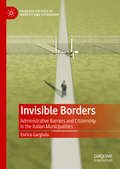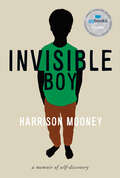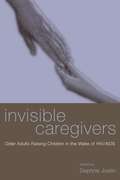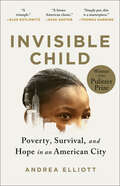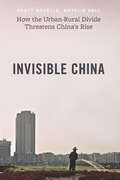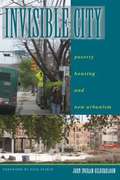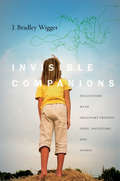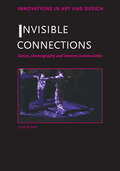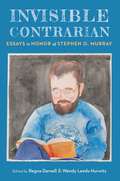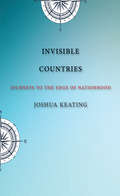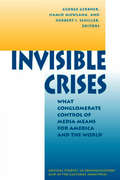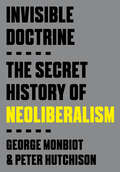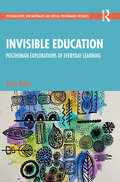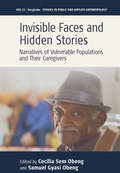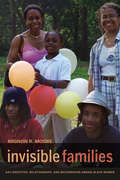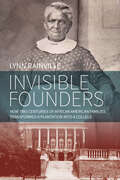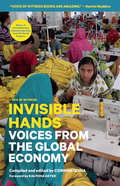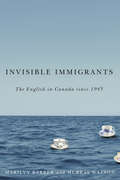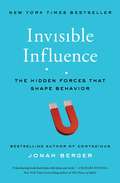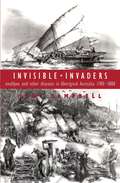- Table View
- List View
Invisible Borders: Administrative Barriers and Citizenship in the Italian Municipalities (Palgrave Politics of Identity and Citizenship Series)
by Enrico GargiuloThis book analyses residency, a form of municipal membership that plays a strategic role in administrative processes in Italy. Residency is a two-faced juridical status: a means for exercising rights and moving freely within a state territory and, at the same time, a tool of control that operates through identification and registration. Gargiulo investigates residency both historically and theoretically, showing that the status of resident is a special kind of border, namely, a status border, which draws the lines of local citizenship. By explaining that the mechanisms of exclusion from residency work as administrative barriers, and showing their aims and effects in terms of civic stratification and differential inclusion, this book contributes to the debates on local citizenship, borders, and discretionary power.‘’While the legal concepts of (un)authorized presence and citizenship in bounded territorial states govern how we envision “immigrants” and debate their treatment, this perceptive book raises novel issues. Local residency registration, studied with rich material from Italy, regulates access to socially distributed resources, and shapes stratification of labor. The case made in this book is original, penetrating, and theoretically insightful. Scholars of migration will want to read this exceptional work.’’ — Josiah Heyman, University of Texas at El Paso, USA‘’Enrico Gargiulo has made an important addition to our sociological understanding of the ways in which states and individuals relate to one another. The humble, often taken-for-granted status of "resident" turns out to be a major pathway to rights and privileges for individuals who have it; those without it may be legal non-persons who barely exist in the eyes of the state. This book is a major contribution to our expanding appreciation of the many kinds of borders, both physical and conceptual, that shape our relationships with the social and political world.’’ — John Torpey, Presidential Professor of Sociology and History, Director, Ralph Bunche, Institute for International Studies, CUNY Graduate Center, USA
Invisible Boy: A Memoir of Self-Discovery (Truth To Power Ser.)
by Harrison MooneyA narrative that amplifies a voice rarely heard—that of the child at the centre of a transracial adoption—and a searing account of being raised by religious fundamentalistsHarrison Mooney was born to a West African mother and adopted as an infant by a white evangelical family. Growing up as a Black child, Harry’s racial identity is mocked and derided, while at the same time he is made to participate in the fervour of his family’s revivalist church. Confused and crushed by fundamentalist dogma and consistently abused for his colour, Harry must transition from child to young adult while navigating and surviving zealotry, paranoia and prejudice.After years of internalized anti-Blackness, Harry begins to redefine his terms and reconsider his history. His journey from white cult to Black consciousness culminates in a moving reunion with his biological mother, who waited twenty-five years for the chance to tell her son the truth: she wanted to keep him.This powerful memoir considers the controversial practice of transracial adoption from the perspective of families that are torn apart and children who are stripped of their culture, all in order to fill evangelical communities’ demand for babies. Throughout this most timely tale of race, religion and displacement, Harrison Mooney’s wry, evocative prose renders his deeply personal tale of identity accessible and light, giving us a Black coming-of-age narrative set in a world with little love for Black children.
Invisible Caregivers: Older Adults Raising Children in the Wake of HIV/AIDS
by Daphne JoslinAn understudied aspect of the HIV/AIDS epidemic is the creation of hundreds of thousands of grandparent-headed households that have become home to children bereft of one or both of their parents. Such "skip-generation parenting" presents a host of challenges to the families involved and the social programs designed to assist them. Despite this unprecedented caregiving responsibility, older surrogate parents remain relatively invisible, hidden in the shadows of HIV care and the demands of raising a child. The primary goal of Invisible Caregivers is to generate, support, and guide program and policy initiatives designed to meet the needs of elder surrogates and their families.Most social service programs are not able to identify the needs of older surrogates, often because these surrogate parents in HIV-infected families are reluctant to make their needs known for fear of social stigma or possible reductions of benefits. Multiple systemic barriers to case management and other services also frustrate attempts to bring available resources to elder caregivers. These barriers include professional ignorance or denial that HIV affects surrogates, eligibility restrictions through CARE, limited funding and age restriction on OAA, and a fragmented health and human service system. Because the issues facing elder caregivers are many and varied, this collection covers a host of issues: community health, aging, HIV services, child welfare, education, public policy, and mental health.
Invisible Chains: Overcoming Coercive Control in Your Intimate Relationship
by Lisa Aronson FontesWhen a man showers all of his attention on a woman, it can feel incredibly romantic, and can blind her to hints of problems ahead. But what happens when that attentiveness becomes domination? In some relationships, the desire to control leads to jealousy, threats, micromanaging--even physical violence. If you or someone you care about are trapped in a web of coercive control, this book provides answers, hope, and a way out. Lisa Aronson Fontes draws on both professional expertise and personal experience to help you:*Recognize controlling behaviors of all kinds.*Understand why this destructive pattern occurs.*Determine whether you are in danger and if your partner can change.*Protect yourself and your kids.*Find the support and resources you need.*Take action to improve or end your relationship.*Regain your freedom and independence.
Invisible Child: Poverty, Survival and Hope in an American City
by Andrea ElliottInvisible Child follows eight dramatic years in the life of a girl whose imagination is as soaring as the skyscrapers near her Brooklyn shelter. Dasani was named after the bottled water that signaled Brooklyn’s gentrification and the shared aspirations of a divided city. <p><p>In this sweeping narrative, Elliott weaves the story of Dasani’s childhood with the history of her family, tracing the passage of their ancestors from slavery to the Great Migration north. As Dasani comes of age, the homeless crisis in New York City has exploded amid the deepening chasm between rich and poor. <p><p>Dasani must guide her siblings through a city riddled by hunger, violence, drug addiction, homelessness, and the monitoring of child protection services. Out on the street, Dasani becomes a fierce fighter to protect the ones she loves. When she finally escapes city life to enroll in a boarding school, she faces an impossible question: What if leaving poverty means abandoning your family, and yourself? <p><p>By turns heartbreaking and inspiring, Invisible Child tells an astonishing story about the power of resilience, the importance of family, and the cost of inequality. Based on nearly a decade of reporting, Invisible Child illuminates some of the most critical issues in contemporary America through the life of one remarkable girl.
Invisible China: How the Urban-Rural Divide Threatens China’s Rise
by Scott Rozelle Natalie HellAs the glittering skyline in Shanghai seemingly attests, China has quickly transformed itself from a place of stark poverty into a modern, urban, technologically savvy economic powerhouse. But as Scott Rozelle and Natalie Hell show in Invisible China, the truth is much more complicated and might be a serious cause for concern. China’s growth has relied heavily on unskilled labor. Most of the workers who have fueled the country’s rise come from rural villages and have never been to high school. While this national growth strategy has been effective for three decades, the unskilled wage rate is finally rising, inducing companies inside China to automate at an unprecedented rate and triggering an exodus of companies seeking cheaper labor in other countries. Ten years ago, almost every product for sale in an American Walmart was made in China. Today, that is no longer the case. With the changing demand for labor, China seems to have no good back-up plan. For all of its investment in physical infrastructure, for decades China failed to invest enough in its people. Recent progress may come too late. Drawing on extensive surveys on the ground in China, Rozelle and Hell reveal that while China may be the second-largest economy in the world, its labor force has one of the lowest levels of education of any comparable country. Over half of China’s population—as well as a vast majority of its children—are from rural areas. Their low levels of basic education may leave many unable to find work in the formal workplace as China’s economy changes and manufacturing jobs move elsewhere. In Invisible China, Rozelle and Hell speak not only to an urgent humanitarian concern but also a potential economic crisis that could upend economies and foreign relations around the globe. If too many are left structurally unemployable, the implications both inside and outside of China could be serious. Understanding the situation in China today is essential if we are to avoid a potential crisis of international proportions. This book is an urgent and timely call to action that should be read by economists, policymakers, the business community, and general readers alike.
Invisible City
by John Ingram GilderbloomA legendary figure in the realms of public policy and academia, John Gilderbloom is one of the foremost urban-planning researchers of our time, producing groundbreaking studies on housing markets, design, location, regulation, financing, and community building. Now, in Invisible City, he turns his eye to fundamental questions regarding housing for the elderly, the disabled, and the poor. Why is it that some locales can offer affordable, accessible, and attractive housing, while the large majority of cities fail to do so? Invisible City calls for a brave new housing paradigm that makes the needs of marginalized populations visible to policy makers. Drawing on fascinating case studies in Houston, Louisville, and New Orleans, and analyzing census information as well as policy reports, Gilderbloom offers a comprehensive, engaging, and optimistic theory of how housing can be remade with a progressive vision. While many contemporary urban scholars have failed to capture the dynamics of what is happening in our cities, Gilderbloom presents a new vision of shelter as a force that shapes all residents.
Invisible Companions: Encounters with Imaginary Friends, Gods, Ancestors, and Angels (Spiritual Phenomena)
by J. Bradley WiggerFrom the US to Nepal, author J. Bradley Wigger travels five countries on three continents to hear children describe their invisible friends—one-hundred-year-old robins and blue dogs, dinosaurs and teapots, pretend families and shape-shifting aliens—companions springing from the deep well of childhood imagination. Drawing on these interviews, as well as a new wave of developmental research, he finds a fluid and flexible quality to the imaginative mind that is central to learning, co-operation, and paradoxically, to real-world rationality. Yet Wigger steps beyond psychological territory to explore the religious significance of the kind of mind that develops relationships with invisible beings. Alongside Cinderella the blue dog, Quack-Quack the duck, and Dino the dinosaur are angels, ancestors, spirits, and gods. What he uncovers is a profound capacity in the religious imagination to see through the surface of reality to more than meets the eye. Punctuated throughout by children's colorful drawings of their see-through interlocutors, the book is highly engaging and alternately endearing, moving, and humorous. Not just for parents or for those who work with children, Invisible Companions will appeal to anyone interested in our mind's creative and spiritual possibilities.
Invisible Connections: Dance, Choreography and Internet Communities (Innovations In Art And Design Ser.)
by Sita PopatThe first and only book to focus on dance on the Internet, Sita Popat‘s fascinating Invisible Connections examines how Internet and communication technologies offer dance and theatre new platforms for creating and performing work, and how opportunities for remote interaction and collaboration are available on a scale never before imaginable.Drawing
Invisible Contrarian: Essays in Honor of Stephen O. Murray (Critical Studies in the History of Anthropology)
by Regna Darnell Wendy Leeds-HurwitzIn Invisible Contrarian Regna Darnell and Wendy Leeds-Hurwitz have assembled scholars to memorialize and celebrate the prescient vision and interdisciplinary contributions of the late Stephen O. Murray (1950–2019), who did pioneering research in ethnolinguistics and anthropology of gender and homosexuality. His socially relevant work continues to provide a cogent example of an emergent, forward-looking anthropology for the twenty-first century. Murray&’s wide-ranging work included linguistics, regional ethnography in Latin America and Asia, activism, history of anthropology in relation to social sciences, and migration studies. Along with a complete list of his publications, Invisible Contrarian highlights Murray&’s methodological innovations and includes key writings that remain little known, since he never pursued a tenured research position. Murray&’s significant, prolific contributions deserve not only to be reexamined but to be shared with contemporary and future audiences. Ideal both as a primer for those who have not yet read Murray&’s work and as an in-depth resource for those already familiar with him, this volume demonstrates the wide-ranging accomplishments of a man who modeled how to be an independent scholar outside an academic position.
Invisible Countries: Journeys to the Edge of Nationhood
by Joshua KeatingA journalist explores how our world&’s borders came to be and how self-proclaimed countries across the globe could change the map. What is a country? While certain basic criteria—borders, a government, and recognition from other countries—seem obvious, journalist Joshua Keating investigates what happens in areas of the world that exist as exceptions to these rules. Invisible Countries looks at semiautonomous countries such as Abkhazia, Kurdistan, and Somaliland, as well as a Mohawk reservation straddling the U.S.-Canada border, and an island nation whose very existence is threatened by climate change. Through stories about these would-be countries&’ efforts at self-determination, Keating shows that there is no universal legal authority determining what a country is. He also argues that economic, cultural, and environmental forces could soon bring an end to our long period of cartographical stasis. Keating combines history with incisive observations drawn from his travels and interviews with residents, political leaders, and scholars in each of these &“invisible countries.&”
Invisible Crimes and Social Harms
by Pamela Davies Peter Francis Tanya WyattThis unique collection explores the continuing invisibility of much crime and victimization, and the lack of adequate responses to them. Shaping the lens through which criminology and victimology is approached in the twenty-first century, the volume examines major issues including (in)justice, risks, rights, regulation and enforcement.
Invisible Crises: What Conglomerate Control of Media Means for America and the World (Critical Studies in Communication and in the Cultural Industries)
by George GerbnerHidden from public sight and mind today are invisible crises that threaten our democracy and existence more than the crises we know about—or think we know about. These invisible crises include the promotion of practices that drug, hurt, poison, and kill thousands every day; cults of violence that desensitize, terrorize, and brutalize; the growing siege mentality of our cities; widening resource gaps and the most glaring inequalities in the industrial world; the costly neglect of vital institutions such as public education and the arts; and media-assisted make-believe image politics corrupting the electoral process.Deprived of sustained attention but bombarded by eruptions of surface consequences (often presented as unique events stripped of historical context), people ar bewildered, fearful, angry, and cynical.The contributors to this volume—exploring such unattended crises, analyzing why they are hidden, and focusing on the increasing concentration of culture-power that keeps them from view—maintain that a profound general crisis of social vision, public communication, and representative government underlies all of the invisible crises.
Invisible Doctrine: The Secret History of Neoliberalism
by George Monbiot Peter HutchisonWe live under an ideology that preys on every aspect of our lives: our education and our jobs; our healthcare and our leisure; our relationships and our mental well-being; the planet we inhabit—the very air we breathe. It is everywhere. Yet for most people, it has no name. It seems inescapable, like a natural law.But trace it back to its roots, and you see that this ideology is neither inevitable nor immutable. It was conceived and propagated—and then concealed—by the powerful few. Our task is to bring it into the light—and to build a new system that is worth fighting for. Neoliberalism.Do you know what it is?
Invisible Doctrine: The Secret History of Neoliberalism
by George Monbiot Peter Hutchison#1 SUNDAY TIMES BESTSELLER • A sharp, fiercely argued takedown of neoliberalism that not only defines this slippery concept but connects it to the climate crisis, poverty, and fascism—and shows us how to fight back.&“Incisive, illuminating, eye-opening—an unsparing anatomy of the great ideological beast stalking our times, often whispered about and yet never so clearly in view.&”—David Wallace-Wells, author of The Uninhabitable EarthNeoliberalism is the dominant ideology of our time. It shapes us in countless ways, yet most of us struggle to articulate what it is. Worse, we have been persuaded to accept this extreme creed as a kind of natural law. In Invisible Doctrine, journalist George Monbiot and filmmaker Peter Hutchison shatter this myth. They show how a fringe philosophy in the 1930s—championing competition as the defining feature of humankind—was systematically hijacked by a group of wealthy elites, determined to guard their fortunes and power. Think tanks, corporations, the media, university departments and politicians were all deployed to promote the idea that people are consumers, rather than citizens.One of the most pernicious effects has been to make our various crises—from climate disasters to economic crashes, from the degradation of public services to rampant child poverty—seem unrelated. In fact, they have all been exacerbated by the &“invisible doctrine,&” which subordinates democracy to the power of money. Monbiot and Hutchison connect the dots—and trace a direct line from neoliberalism to fascism, which preys on people&’s hopelessness and desperation.Speaking out against the fairy tale of capitalism and populist conspiracy theories, Monbiot and Hutchison lay the groundwork for a new politics, one based on truly participatory democracy and &“private sufficiency, public luxury&”: an inspiring vision that could help bring the neoliberal era to an end.
Invisible Education: Posthuman Explorations of Everyday Learning (Postqualitative, New Materialist and Critical Posthumanist Research)
by Jocey QuinnThis original and challenging book introduces the ground-breaking concept of ‘invisible education’, theorising it with critical posthuman concepts and demonstrating it through a wide range of empirical research. Invisible education is the learning that happens in everyday life: it is invisible because it is purposively ignored and devalued, and it is education because it is powerful and formative. Far from being marginal, this is where the future is being formed. The book challenges the feel-good fiction of social mobility through formal education, replacing it with the new concept of future mutabilities, shaped through invisible education. The book is the first to bring together lifelong learning and critical posthumanism and does so in ways that are mutually illuminating. The book draws on a wide range of funded empirical research on invisible education: exploring landscapes, animals and things (material, immaterial and uncanny), activism, volunteering and work, home lives and care, and global contexts of conflict. It charts how invisible education plays a crucial role in the lives of marginalised people, including young people, activists, postverbal people, carers, women escaping domestic abuse and many others. Combining posthuman ideas with memoir, poetry, art and fiction, it is creative, intellectually stimulating and readable.
Invisible Faces and Hidden Stories: Narratives of Vulnerable Populations and Their Caregivers (Studies in Public and Applied Anthropology #12)
by Cecilia Sem Obeng Samuel Gyasi ObengDealing with narratives of vulnerable populations, this book looks at how they deal with dimensions of their social life, especially in regards to health. It reflects the socio-political ecologies like public hostility and stereotyping, neglect of their unique health needs, their courage to overcome adversity, and the love of family and healthcare providers in mitigating their problems. American society likes to give the impression that it is listening to the plight of vulnerable populations, but the stories in this volume prove otherwise.
Invisible Faces and Hidden Stories: Narratives of Vulnerable Populations and Their Caregivers (Studies in Public and Applied Anthropology #12)
by Cecilia Sem Obeng and Samuel Gyasi ObengDealing with narratives of vulnerable populations, this book looks at how they deal with dimensions of their social life, especially in regard to health. It reflects the socio-political ecologies like public hostility and stereotyping, neglect of their unique health needs, their courage to overcome adversity, and the love of family and healthcare providers in mitigating their problems. The narratives inform us about the dissimilarity between the way we speak, what we hear and how we act. American society likes to give the impression that it is listening to the plight of vulnerable populations, but the stories in this volume prove otherwise.
Invisible Families: Gay Identities, Relationships, and Motherhood Among Black Women
by Mignon MooreMignon R. Moore brings to light the family life of a group that has been largely invisible--gay women of color--in a book that challenges long-standing ideas about racial identity, family formation, and motherhood. Drawing from interviews and surveys of one hundred black gay women in New York City, Invisible Families explores the ways that race and class have influenced how these women understand their sexual orientation, find partners, and form families. In particular, the study looks at the ways in which the past experiences of women who came of age in the 1960s and 1970s shape their thinking, and have structured their lives in communities that are not always accepting of their openly gay status. Overturning generalizations about lesbian families derived largely from research focused on white, middle-class feminists, Invisible Families reveals experiences within black American and Caribbean communities as it asks how people with multiple stigmatized identities imagine and construct an individual and collective sense of self.
Invisible Founders: How Two Centuries of African American Families Transformed a Plantation into a College
by Lynn RainvilleLiteral and metaphorical excavations at Sweet Briar College reveal how African American labor enabled the transformation of Sweet Briar Plantation into a private women’s college in 1906. This volume tells the story of the invisible founders of a college founded by and for white women. Despite being built and maintained by African American families, the college did not integrate its student body for sixty years after it opened. In the process, Invisible Founders challenges our ideas of what a college “founder” is, restoring African American narratives to their deserved and central place in the story of a single institution — one that serves as a microcosm of the American South.
Invisible Girls: The Truth About Sexual Abuse
by Patti FeuereisenA powerful source of healing for teen girls and young women who have experienced sexual abuse, Invisible Girls offers survivors agency and hope in an era when too many girls have suffered aloneThe statistics are staggering. One in four girls will experience sexual abuse by the time she is sixteen, and 48 percent of all rapes involve a young woman under the age of eighteen. It's not surprising then, that in a society where sexual abuse of young women is rampant, many women never share their stories. They remain hidden and invisible. In her pioneering work with young survivors through the last thirty years, Dr. Patti Feuereisen has helped teen girls and young women to find their voices, begin healing, and become visible. In this revised second edition, Dr. Patti's gentle guidance and the girls' powerful stories continue to create an encouraging message: Remarkable healing is possible if girls learn to share their stories in their teens and early twenties. With a new introduction, new chapters, and updated resources, this new edition of Invisible Girls has even more to offer girls, young women, and those who care about them.
Invisible Hands
by Corinne GoriaThe men and women in Invisible Hands reveal the human rights abuses occurring behind the scenes of the global economy. These narrators - including phone manufacturers in China, copper miners in Zambia, garment workers in Bangladesh, and farmers around the world - reveal the secret history of the things we buy, including lives and communities devastated by low wages, environmental degradation, and political repression. Sweeping in scope and rich in detail, these stories capture the interconnectivity of all people struggling to support themselves and their families. Narrators include Kalpona, a leading Bangladeshi labor organizer who led her first strike at 15; Han, who, as a teenager, began assembling circuit boards for an international electronics company based in Seoul; Albert, a copper miner in Zambia who, during a wage protest, was shot by representatives of the Chinese-owned mining company that he worked for; and Sanjay, who grew up in the shadow of the Bhopal chemical disaster, one of the worst industrial accidents in history.
Invisible Immigrants: The English in Canada since 1945
by Marilyn Barber Murray WatsonDespite being one of the largest immigrant groups contributing to the development of modern Canada, the story of the English has been all but untold. In Invisible Immigrants, Barber and Watson document the experiences of English-born immigrants who chose to come to Canada during England’s last major wave of emigration between the 1940s and the 1970s. Engaging life story oral histories reveal the aspirations, adventures, occasional naïveté, and challenges of these hidden immigrants. Postwar English immigrants believed they were moving to a familiar British country. Instead, like other immigrants, they found they had to deal with separation from home and family while adapting to a new country, a new landscape, and a new culture. Although English immigrants did not appear visibly different from their new neighbours, as soon as they spoke, they were immediately identified as “foreign.” Barber and Watson reveal the personal nature of the migration experience and how socio-economic structures, gender expectations, and marital status shaped possibilities and responses. In postwar North America dramatic changes in both technology and the formation of national identities influenced their new lives and helped shape their memories. Their stories contribute to our understanding of postwar immigration and fill a significant gap in the history of English migration to Canada.
Invisible Influence: The Hidden Forces that Shape Behavior
by Jonah BergerThe New York Times bestselling author of Contagious explores the subtle, secret influences that affect the decisions we make--from what we buy, to the careers we choose, to what we eat--in this fascinating and groundbreaking work.If you're like most people, you think that your choices and behaviors are driven by your individual, personal tastes, and opinions. You wear a certain jacket because you liked the way it looked. You picked a particular career because you found it interesting. The notion that our choices are driven by our own personal thoughts and opinions is patently obvious. Right? Wrong. Without our realizing it, other people's behavior has a huge influence on everything we do at every moment of our lives, from the mundane to the momentous occasion. Even strangers have a startling impact on our judgments and decisions: our attitudes toward a welfare policy shift if we're told it is supported by Democrats versus Republicans (even though the policy is the same in both cases). But social influence doesn't just lead us to do the same things as others. In some cases we conform, or imitate others around us. But in other cases we diverge, or avoid particular choices or behaviors because other people are doing them. We stop listening to a band because they go mainstream. We skip buying the minivan because we don't want to look like a soccer mom. In his surprising and compelling Invisible Influence, Jonah Berger integrates research and thinking from business, psychology, and social science to focus on the subtle, invisible influences behind our choices as individuals. By understanding how social influence works, we can decide when to resist and when to embrace it--and how we can use this knowledge to make better-informed decisions and exercise more control over our own behavior.
Invisible Invaders: Smallpox and other diseases in Aboriginal Australia 1780-1880
by Judy CampbellAn epidemic of smallpox among Aboriginal people around the infant colony of Sydney in 1789 puzzled the British, for there had been no cases on the ships of the First Fleet. Where, then, did the epidemic come from? As explorers moved further inland, they witnessed other epidemics of smallpox, notably in the late 1820s and early 1830s and again in the 1860s and 1870s. They also encountered many pockmarked survivors of early epidemics. In Invisible Invaders, Judy Campbell argues that epidemics of smallpox among Australian Aboriginals preceded European settlement. She believes they originated in regular visits to the northern coast of Australia by Macassan fishermen from southern Sulawesi and nearby islands. They were searching for trepang, for which there was a profitable market in China. The Macassan fishermen usually visited during the monsoon season, and the local Indigenous people traded with them. Once the monsoon was over, these Aboriginals resumed their travels into the interior for food, social contact and ritual events, carrying small pox with them. Smallpox thus slowly moved across the continent, eventually reaching the south-east, where it was first recorded by Europeans. Judith Campbell's research on the incidence of smallpox and other diseases among Aboriginal people has extended over more than twenty years. Accumulating evidence from other disciplines supports her findings.
